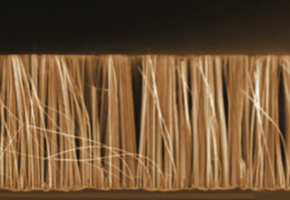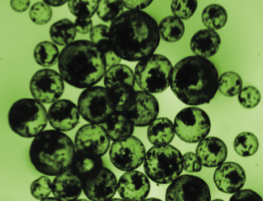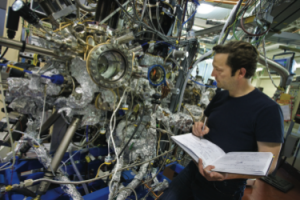Four inventions from the U.S. Department of Energy’s Lawrence Berkeley National Laboratory have been recognized with the R&D 100 award for 2010 from R&D Magazine, which recognizes the 100 most significant proven technological advances of the year.
The awards bring the total of Berkeley Lab’s R&D 100 wins to 56 plus two Editors Choice Awards over the years.
“I want to congratulate all of this year’s winners on their awards and to thank them for their work,” Energy Secretary Steven Chu said. “The large number of winners from the Department of Energy’s national labs every year is a clear sign that our labs are doing some of the most innovative research in the world. This work benefits us all by enhancing America’s competitiveness, ensuring our security, providing new energy solutions, and expanding the frontiers of our knowledge. Our national labs are truly national treasures, and it is wonderful to see their work recognized once again.”
The 2010 awardees are:
- Home Energy Saver/Hohm—a free online web tool that identifies a range of energy-saving upgrades specific to each user’s home construction and geographic location.
- Rough Silicon Nanowires for Waste Heat Utilization—a thermoelectric material that can be used to recover waste heat from automobiles, airplanes, power plants and other sources to offset energy use.
- Chemicals on Demand—laser-triggered microcapsules designed to provide controlled, remote delivery of materials such as cancer therapeutics or surgical glue for hip replacements, or industrial products such as self-repairing electronics and self-healing paint.
- APPELS: Differentially Pumped Ambient Pressure PhotoElectron Lens System for Photoemission Studies—enables scientists to use X–ray photoelectron spectroscopy to analyze liquid/gas and solid/gas interactions at ambient pressures, studies that should accelerate the development of more efficient catalysts, improved fuel cells and solar cells, and a greater understanding of the effect of atmospheric pollutants on ozone.
Home Energy Saver/Hohm
Berkeley Lab scientists Evan Mills and Rich Brown developed the Home Energy Saver (hes.lbl.gov or HomeEnergySaver.lbl.gov), a free online tool that helps consumers identify the best, most cost-effective ways to save energy and reduce greenhouse gas emissions from their homes. A powerful building energy simulation program is at the core of HES, providing each user with a customized home energy profile and recommendations for home improvements that can be readily made. The Web-based interface makes it easy for millions of potential users without any special knowledge of home energy technologies and retrofitting to get energy use and savings estimates tailored to their home, climate, and lifestyle.
 The Berkeley Lab technology was licensed by award co-nominee Microsoft in 2009 for its online application Hohm, www.microsoft-hohm.com. Both tools feature an advanced, easy-to-use graphical interface that allows the user to customize inputs to a significant degree. HES and Hohm quickly provide users with a set of efficiency recommendations based on the answers to only 15 questions.
The Berkeley Lab technology was licensed by award co-nominee Microsoft in 2009 for its online application Hohm, www.microsoft-hohm.com. Both tools feature an advanced, easy-to-use graphical interface that allows the user to customize inputs to a significant degree. HES and Hohm quickly provide users with a set of efficiency recommendations based on the answers to only 15 questions.
Buildings use 40 percent of the total energy consumed in the United States for lighting, heating and cooling, appliances and other applications. Residential buildings account for half the energy consumed by all U.S. buildings, making them a fertile sector for cost-effective reductions in greenhouse gas emissions.
As of January 2010, Home Energy Saver had more than 6 million unique visitors. About one-third of users report making energy-efficient improvements to their homes based on its recommendations. Although other energy calculators are available on the Internet, Home Energy Saver is the only tool to offer such a high degree of customization and to use actual nationwide electricity tariffs. Home Energy Saver is supported by the DOE’s Building Technologies Program in the Office of Energy Efficiency and Renewable Energy.
Rough Silicon Nanowires for Waste Heat Utilization
Berkeley Lab scientists Peidong Yang, Allon Hochbaum, Renkun Chen, Raul Diaz Delgado and Arun Majumdar (while still at Berkeley Lab, before his appointment as DOE’s ARPA-E Director in October 2009) manipulated silicon to make nanowires of about 50 to 100 nm in diameter,  and by switching to a far less expensive manufacturing process, happened to create a surface with an abundance of defects. This transformational new material, Rough Silicon Nanowires, has a rough surface that impedes phonons, the particles that transport heat, yet allows the free movement of electrons, which carry the electric charge. In this way, the scientists transformed silicon from a bad to a good thermoelectric, marking perhaps the most important discovery in thermoelectricity in recent times.
and by switching to a far less expensive manufacturing process, happened to create a surface with an abundance of defects. This transformational new material, Rough Silicon Nanowires, has a rough surface that impedes phonons, the particles that transport heat, yet allows the free movement of electrons, which carry the electric charge. In this way, the scientists transformed silicon from a bad to a good thermoelectric, marking perhaps the most important discovery in thermoelectricity in recent times.
Scientists had been searching for years for a new solid-state material that could improve upon the efficiency of bismuth telluride, the state-of-the-art thermoelectric for the last five decades. However, bismuth telluride is difficult to make and also not efficient at higher temperatures, making it unusable for waste heat recovery.
The material developed at Berkeley Lab offers greater stability and lower material and manufacturing costs than other thermoelectrics. Because of its low cost, it is the only existing material suited to large-scale waste heat recovery. Nearly two-thirds of all the energy produced in the world is lost as heat. More than half the energy in a gallon of gas leaves automobiles as waste heat. Waste heat is a free source of energy that is almost wholly unused today because large-scale waste heat recovery has not been feasible. But Berkeley Lab has achieved a major advance in developing a new thermoelectric material made with an inexpensive, safe, and abundant element. The Rough Silicon Nanowires were developed with support from the DOE’s Office of Science.
Chemicals on Demand
A team of Berkeley Lab and UC Berkeley researchers including Alex Zettl, Jean Fréchet, David Okawa and Stefan Pastine used light-responsive carbon nanotubes to create the first cost-efficient, remotely triggerable, impermeable microcapsules. Chemicals on Demand microcapsules rupture and release their contents when exposed to laser light. These smart  microcapsules consist of nylon spheres about the size of a grain of sand that enclose a liquid chemical sprinkled with carbon nanotubes. The nanotubes convert laser light to heat that bursts the microcapsule. Their extreme versatility promises to deliver “chemicals on demand ” for a wide range of applications, particularly in the biomedical and industrial chemical and electronics fields.
microcapsules consist of nylon spheres about the size of a grain of sand that enclose a liquid chemical sprinkled with carbon nanotubes. The nanotubes convert laser light to heat that bursts the microcapsule. Their extreme versatility promises to deliver “chemicals on demand ” for a wide range of applications, particularly in the biomedical and industrial chemical and electronics fields.
In the biomedical field, for example, Chemicals on Demand microcapsules could be used to deliver cancer therapies in a highly targeted way, destroying cancer cells before they have metastasized while reducing side effects. This should be especially effective for treating cancer of the breast. The technology could also be used to provide controlled-release surgical glue, reducing errors in hip-replacement surgeries.
In the industrial chemical and electronics fields, Chemicals on Demand microcapsules could help reduce the 20 to 50 million tons of electronic waste generated worldwide each year, almost all of which ends up in developing countries, where workers use open fires and acid baths to melt down gold, silver, copper, and other valuable metals into scrap metal for resale. Such unsafe practices spew toxic fumes and runoff into the air and water. The Chemicals on Demand technology could be used to make self-repairing materials for use in the electronics industry, as well as in the construction, personal care and automobile industries. The research was supported by the National Science Foundation and the DOE’s Office of Science.
APPELS: Differentially Pumped Ambient Pressure PhotoElectron Lens System for Photoemission Studies
An international collaboration that included Berkeley Lab scientists Frank Ogletree, Hendrik Bluhm, Zahid Hussain and Miquel Salmeron, working at Berkeley Lab’s Advanced Light Source  (ALS), developed a novel lens system that makes possible the use of X-ray Photoelectron Spectroscopy technology under pressures and humidities similar to those encountered in the natural environment. Called the Ambient Pressure PhotoElectron Lens System (APPELS), this new technique has already led to groundbreaking discoveries in climate change, atmospheric science, nanotechnology and industrial processes, such as heterogeneous catalysis. Also part of the collaboration were SPECS GmbH, a German firm that designs and produces surface analysis instruments, and Robert Schlögl of the Franz Haber Institute of the Max Planck Society.
(ALS), developed a novel lens system that makes possible the use of X-ray Photoelectron Spectroscopy technology under pressures and humidities similar to those encountered in the natural environment. Called the Ambient Pressure PhotoElectron Lens System (APPELS), this new technique has already led to groundbreaking discoveries in climate change, atmospheric science, nanotechnology and industrial processes, such as heterogeneous catalysis. Also part of the collaboration were SPECS GmbH, a German firm that designs and produces surface analysis instruments, and Robert Schlögl of the Franz Haber Institute of the Max Planck Society.
X-ray Photoelectron Spectroscopy (XPS) is a well-established scientific technique for identifying the constituent elements in a sample by detecting their unique spectral signals. However, XPS is typically performed in a vacuum or at pressures below 4.6 torr, which is the scientifically and technically important vapor pressure of water at the triple point and the critical threshold pressure for environmental science studies. Through a technique called pressure differential pumping, the APPELS technology allows measurements at pressures of more than 10 torr. This enables investigators using APPELS to improve climate change models, ward off the damaging effects of humidity on nanosystems, provide insights into the impact of chemicals on agricultural plants and human health, and aid in controlling the pollution of air, water and other environmental systems. With APPELS, it is possible to observe chemical interactions at the atomic level for gas/liquid and liquid/solid interfaces at ambient pressures.
APPELS is now part of XPS instruments being used on two beamlines at the ALS, and on beamlines at other synchrotrons around the world, including the National Synchrotron Light Source at Brookhaven National Laboratory, BESSY and the Centre for Synchrotron Radiation in Germany, the MAX-lab synchrotron in Sweden, and the ALBA synchrotron in Spain. In addition, Sweden’s Gammadata is offering an instrument that relies on APPELS technology. APPELS was developed with support from the DOE’s Office of Science, with additional support from Berkeley Lab’s Laboratory Directed Research and Development (LDRD) program.
Said Cheryl Fragiadakis, who heads Berkeley Lab’s Technology Transfer and Intellectual Property Management Department, which nominated the technologies: “This year’s winners from Berkeley Lab embody the high quality research and focus on impactful application that are the hallmark of our work. It is terrific to have the additional recognition conferred by the R&D 100 awards. I join with the rest of Berkeley Lab in congratulating our staff and our partners!”
All winners of the 2010 award will receive a plaque at R&D Magazine’s formal awards banquet Nov. 11 in Orlando, FL.
Lawrence Berkeley National Laboratory provides solutions to the world’s most urgent scientific challenges including clean energy, climate change, human health, and a better understanding of matter and force in the universe. Berkeley Lab is a world leader in improving our lives and knowledge of the world around us through innovative science, advanced computing and technology that makes a difference. Berkeley Lab is a U.S. Department of Energy (DOE) national laboratory. It conducts unclassified scientific research and is managed by the University of California for the DOE Office of Science. Visit our website.
Additional information:
- Berkeley Lab’s previous R&D 100 winners
- Learn more about the Technology Transfer and Intellectual Property Management Department